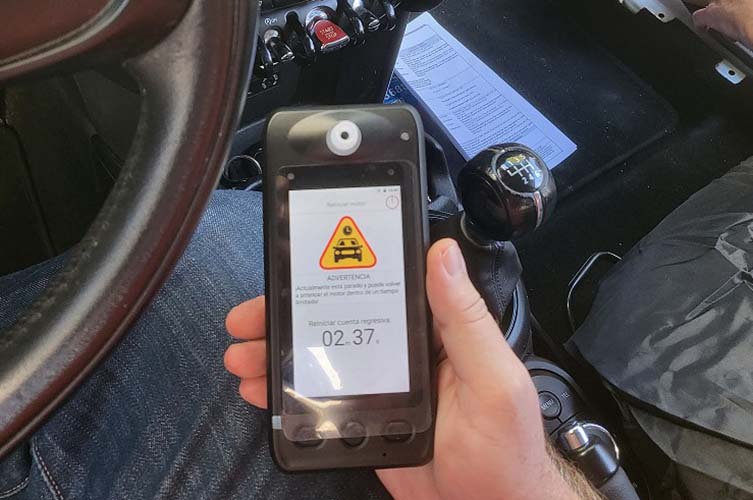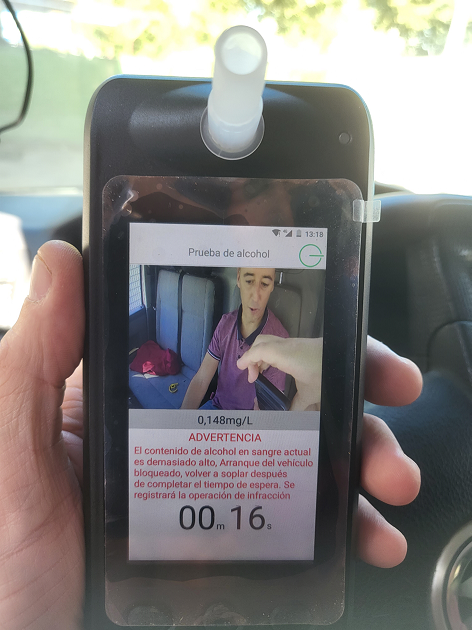
ALCOLOCK interlock breathalyzer. Operation, mandatory use and legal responsibilities in case of accidents.
Driving under the influence of alcohol is still a serious problem in our country. The percentage of accidents is very high, both in professional and private drivers.
A daily average of 450 drivers under the influence of alcohol and drugs have been detected. In the case of alcohol, professional drivers, motorcyclists and novel drivers accounted for 3.9% of the positives in the last campaign (with 18, 35 and 48 cases respectively) .
For this reason, a new technological solution has emerged: the ALCOLOCK breathalyzer. The purpose of this breathalyzer is to prevent people from driving if they exceed the maximum alcohol levels permitted.
How does an antilock breathalyzer work?
The antilock breathalyzer is an electronic system that forces the driver to blow into a device in order to start the vehicle. If the driver exceeds the alcohol limits or levels programmed into the equipment, the ignition is automatically locked and driving is impeded.
Who is required by law to install an antilock?
At the moment, it is not mandatory to carry an ALCOLOCK. However, from 6 July 2022, vehicles of category M2 or M3 that do not have this device installed cannot be approved for circulation.
Category M2 vehicles are those intended for the transport of persons with more than 8 seats (in addition to the driver himself), with a maximum permissible mass equal to or less than 5 tons.
Vehicles of category M3 meet the same requirements, but the maximum permissible mass is more than 5 tons.
At this time, this regulation does not affect vehicles prior to that date, although it is expected that in 2024 the law will apply to all vehicles, regardless of their year. Therefore, all models that are marketed thereafter will have to have an ALCOLOCK or antilock breathalyzer to be able to operate in Europe.
What regulations govern ALCOLOCK?
ALCOLOCK breathalyzers marketed in Europe must comply with the European standard EN 50436 Alcohol Ignition Interlock with the certificate issued by an authorized accrediting body.
In addition, the regulation of the use of ALCOLOCK in Spain has been established in the Fifteenth Additional Provision of the new Traffic Law and reads as follows:
“From 6 July 2022, vehicles of category M2 and M3 with a standardized interface for the installation of breathalyzers intended for the transport of passengers shall be fitted with antilock breathalyzers. Drivers of these vehicles will be obligated to use these vehicle control devices”.
How the antilock breathalyzer (ALCOLOCK) works:
“The ALCOLOCK is installed in the vehicle via a cable that connects it to the dashboard. Once it is turned on, the driver will have to blow through the mouthpiece of the device. The breathalyzer will analyze the exhaled air in about 25 seconds, from 0 to 2.5 mg / l.”
If the exhaled air level exceeds the maximum permitted BAC level, the ALCOLOCK will emit an acoustic signal and prevent the vehicle from starting. If the authorized level is not exceeded, the driver may drive the vehicle. If a longer stop is made in an interval of 3-30 minutes, the driver will have to repeat the test in order to start.
To prevent the impersonation of the test taker, some ALCOLOCK devices optionally include a biometric camera that recognizes the driver. This function may be restricted by data protection regulations if it is not explicitly authorized by the driver.
Liabilities and legal scope in case of an alcohol-related accident.
The driver responsible for an accident that tests positive in a breathalyzer test must face on the one hand a criminal sanction, and on the other hand the possible compensations that may be required later by the insurer of the vehicle he was driving.
With regard to criminal sanctions, it is customary to reach an agreement with the prosecution at the beginning of the proceedings (within a speedy trial). This agreement usually leads to an acceptance of the facts in exchange for a reduced sentence. The most common agreements (except in cases of recidivism) usually involve a withdrawal of the registration certificate for a period of between one year and a year and a half, plus a fine according to the income of the offender, or a community service sentence for thirty or forty days (see article 379 of the Criminal Code).
More unpredictable is the issue of civil liability. The insurance of the causative vehicle, as we have said, is obliged to bear all the damages and expenses produced as a result of the traffic accident (damage to urban furniture, hospital and rehabilitation expenses of the victims, compensation of the injured …) Once you have paid all these amounts, the insurer will make use of the power of recourse granted by law, so in the first instance it will send a fax to the responsible driver claiming the amount and, in case of not obtaining a favorable response, it will file the appropriate lawsuit.
Accident with breathalyzer: the owner or insured not driver.
There are also doubts regarding the responsibility of the owner and / or insured of the car driven by the originator. In this case, Article 10 of the LRCSCVM is quite clear:
Article 10 Power of recourse:
The insurer, once the payment of the compensation has been made, may issue a recourse:
- Against the driver, the owner of the causative vehicle and the insured, if the damage caused was due to the willful conduct of any of them or driving under the influence of alcoholic beverages or toxic drugs, narcotics or psychotropic substances.
- Against the third party responsible for the damages.
- Against the policyholder or insured, for the reasons provided for in Law 50/1980, of October 8, on Insurance Contracts, and, in accordance with the provisions of the contract, in the case of driving the vehicle by someone without a driver’s license.
If we look at section A of the article, it is clear that the insurer can repeat the coverage and expenses that it has paid to third parties against the driver, the owner and the insured.
The approved ALCOVISOR X8 antilock breathalyzer is an advanced breathalyzer device for drivers that immobilizes the vehicle in positive test cases. Optionally, to prevent sabotage, it can include the driver’s facial recognition function.
This is a team developed in Spain for the needs of the European market. CDP- ALCOVISOR has more than 20 years of experience in this field and has carried out tens of thousands of installations around the world. Its extensive experience and the exceptional appreciation of the service and use by its users has made CDP-ALCOVISOR a leading company in the market. The ALCOVISOR X8 breathalyzer is a safe investment that guarantees a flawless long-term operation. In addition, it has a permanent and professional after-sales service carried out by qualified personnel accredited by the brand following strict quality standards.
This breathalyzer will allow you to implement a planned strategy for breathalyzer control in drivers. It may be use professionally (in private vehicles or fleets) or privately.The Alcovisor X8 anti-start breathalyzer allows the option of image verification and biometric access if you wish to activate this function:

